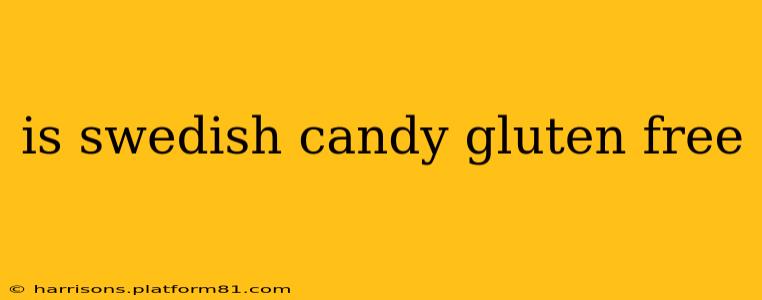Sweden boasts a rich confectionery tradition, with a wide variety of candies, chocolates, and sweets. However, for those with celiac disease or gluten sensitivity, determining whether these treats are safe can be tricky. This guide will explore the gluten-free status of Swedish candy, addressing common concerns and offering helpful tips for making informed choices.
What Makes Swedish Candy Gluten-Free (or Not)?
The gluten-free status of Swedish candy heavily depends on its ingredients. Many traditional candies use simple sugars, fruits, and nuts – naturally gluten-free ingredients. However, some manufacturers might add ingredients containing gluten, such as:
- Modified starches: Some starches used as thickeners or stabilizers can be derived from wheat, barley, or rye.
- Malted barley extract: This adds a distinctive flavor to some candies.
- Flavorings and additives: Certain flavorings or colorings might contain gluten as a processing aid. This is less common but still a possibility.
- Cross-contamination: Manufacturing facilities that process both gluten-containing and gluten-free products may run the risk of cross-contamination.
Therefore, simply assuming a candy is gluten-free based on its origin or appearance is insufficient. Always check the label.
How to Determine if Your Swedish Candy is Gluten-Free
The most reliable way to determine if your Swedish candy is gluten-free is to carefully examine the ingredient list. Look for any mention of:
- Wheat: Including wheat flour, wheat starch, or wheat derivatives.
- Barley: Including barley malt, barley flour, or barley extract.
- Rye: Including rye flour or rye extract.
- Gluten: Any mention of gluten, even in small amounts, indicates the presence of gluten.
If any of these are listed, the candy is not gluten-free. If the ingredients list is unclear or you're unsure about a specific ingredient, contact the manufacturer directly for clarification.
Are There Gluten-Free Options Available in Sweden?
Yes, there are increasing numbers of gluten-free candies and sweets available in Sweden. Many manufacturers are catering to the growing demand for gluten-free products, offering clearly labeled alternatives. Look for products explicitly marked as "glutenfri" (gluten-free) on the packaging. Health food stores and larger supermarkets often have dedicated sections for gluten-free products.
What About Importing Swedish Candy?
When importing Swedish candy, extra caution is needed. Language barriers can make it difficult to interpret labels. Use translation apps to decipher the ingredient list, but still proceed with caution. If you have a severe gluten intolerance, it's safest to avoid imported candies unless you can confirm their gluten-free status directly from the manufacturer or an authorized importer.
What if I Accidentally Consume Gluten-Containing Swedish Candy?
If you accidentally consume gluten-containing Swedish candy and have celiac disease or gluten sensitivity, monitor your body for any symptoms such as abdominal pain, bloating, diarrhea, or fatigue. If you experience severe symptoms, consult a doctor immediately.
Is all "natural" Swedish Candy Gluten-Free?
Not necessarily. Even candies made with natural ingredients can contain gluten if they've been processed in a facility that also handles gluten-containing products or if gluten-containing ingredients were added during production. Always check the label.
Conclusion
Determining if Swedish candy is gluten-free requires careful label examination. While many traditional candies may be naturally gluten-free, always verify the ingredient list to ensure it is safe for those with gluten sensitivities. Prioritizing clearly labeled gluten-free options will help you enjoy Swedish sweets without compromising your health.
